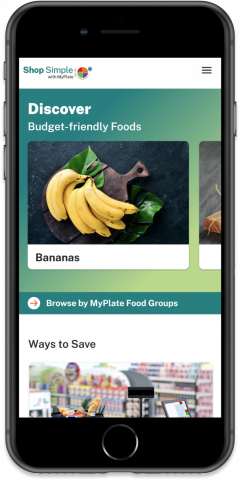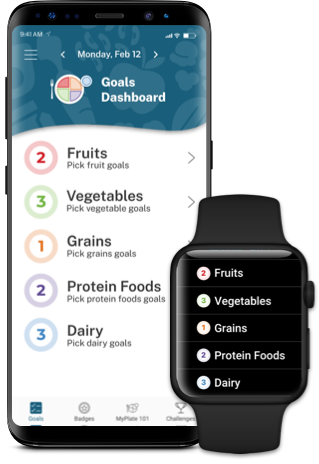Vegetables
Vary your veggies.
What foods are in the Vegetable Group?
Any vegetable or 100% vegetable juice counts as part of the Vegetable Group. Vegetables may be raw or cooked and can be fresh, frozen, canned, or dried. They can be whole, cut-up, or puréed (mashed).
Vegetables are organized into 5 subgroups based on their nutrients: dark green; red and orange; beans, peas, and lentils; starchy; and other vegetables.
More About the Vegetable Group
Note: Click on the top row to expand the table. If you are on a mobile device, you may need to turn your phone sideways to see the full table.
*These are general recommendations by age. Find the right amount for you by getting your MyPlate Plan.
| Daily Recommendation* | ||
|---|---|---|
| Toddlers | 12 to 23 months | ⅔ to 1 cup |
| Children | 2-3 yrs | 1 to 1½ cups |
| 4-8 yrs | 1½ to 2½ cups | |
| Girls | 9-13 yrs | 1½ to 3 cups |
| 14-18 yrs | 2½ to 3 cups | |
| Boys | 9-13 yrs | 2 to 3½ cups |
| 14-18 yrs | 2½ to 4 cups | |
| Women | 19-30 yrs | 2½ to 3 cups |
| 31-59 yrs | 2 to 3 cups | |
| 60+ yrs | 2 to 3 cups | |
| Men | 19-30 yrs | 3 to 4 cups |
| 31-59 yrs | 3 to 4 cups | |
| 60+ yrs | 2½ to 3½ cups | |
| Amount that counts as 1 cup of vegetables | ||
|---|---|---|
| Dark-Green Vegetables | Broccoli | 1 cup, chopped or florets, fresh or frozen |
| Bitter melon leaves, chrysanthemum leaves, escarole, lambsquarters, nettles, poke greens, taro leaves, turnip greens | 1 cup, cooked | |
| Amaranth leaves, beet greens, bok choy, broccoli rabe (rapini), chard, collards (collard greens), cress, dandelion greens, kale, mustard greens, spinach, Swiss chard, watercress |
1 cup, cooked 2 cups, fresh, canned, or frozen |
|
| Raw leafy greens: Arugula (rocket), basil, cilantro, dark green leafy lettuce, endive, escarole, mixed greens, mesclun, romaine |
2 cups, fresh |
|
| Red and Orange Vegetables | Carrots |
2 medium carrots |
| Pimento/Pimiento | 3 whole 1 cup |
|
| Pumpkin, calabaza | 1 cup, mashed, cooked | |
| Red and orange bell peppers |
1 large bell pepper |
|
| Red chili peppers | ¾ cup | |
| Sweet potato | 1 large sweet potato, baked 1 cup, sliced or mashed, cooked |
|
| Tomatoes | 1 large tomato 2 small tomatoes 1 cup, chopped or sliced, fresh, canned, or cooked |
|
| 100% vegetable juice | 1 cup | |
| Winter squash (acorn, butternut, Hubbard, kabocha) | 1 cup cubed, cooked, fresh, or frozen | |
| Beans, Peas, and Lentils | Dry beans and peas and lentils (such as bayo, black, brown, fava, garbanzo, kidney, lima, mung, navy, pigeon, pink, pinto, soy, or white beans, or black-eyed peas (cow peas) or split peas, and red, brown, and green lentils) | 1 cup, whole or mashed, cooked |
| Starchy Vegetables | Breadfruit | 1 ½ cups, cooked |
| Cassava | ¾ cup, cooked | |
| Corn, yellow or white | 1 large ear of corn 1 cup corn kernels, fresh or frozen |
|
| Green peas | 1 cup, fresh or frozen | |
| Hominy | 1 cup, cooked | |
| Plantains | ¾ cup, cooked | |
| White potatoes | 1 medium white potato, boiled or baked 1 cup, diced, mashed, fresh or frozen |
|
| Other Vegetables | Asparagus | 1 cup |
| Avocado | 1 avocado | |
| Bamboo shoots | 1 cup | |
| Bean sprouts | 1 cup, cooked | |
| Cabbage, green, red, napa, savoy | 1 cup, chopped or shredded raw or cooked | |
| Cactus pads (nopales) | 5 pads 1 cup sliced |
|
| Cauliflower | 1 cup, pieces or florets raw or cooked, fresh or frozen | |
| Celery |
1 cup, diced or sliced, raw or cooked 2 large stalks (11" to 12" long) |
|
| Cucumbers | 1 cup, raw, sliced or chopped | |
| Green or wax beans | 1 cup, raw or cooked, fresh or frozen | |
| Green bell peppers |
1 large bell pepper 1 cup, chopped, raw or cooked, fresh or frozen |
|
| Lettuce, iceberg or head | 2 cups, raw, shredded or chopped | |
| Mushrooms | 1 cup, raw or cooked | |
| Okra | 1 cup, cooked | |
| Onions | 1 cup, chopped, raw or cooked | |
| Summer squash or zucchini | 1 cup, cooked, sliced or diced | |
Why is it important to eat vegetables?
Eating vegetables provides health benefits. People who eat fruits and vegetables as part of an overall healthy diet are likely to have a reduced risk of some diseases. Vegetables provide nutrients vital for the health and maintenance of the body.

Health Benefits
All food and beverage choices matter. Focus on variety, amount, and nutrition.
- As part of an overall healthy diet, eating foods lower in calories per cup, such as vegetables, instead of higher-calorie food may help you lower your calorie intake.
- Eating a diet rich in vegetables and fruits as part of an overall healthy diet may reduce the risk for heart disease, including heart attack and stroke.
- Eating a diet rich in vegetables and fruits as part of an overall healthy diet may protect against certain types of cancers.
- Adding vegetables helps increase fiber and potassium, which many Americans do not get enough of.
Food Group Gallery
Do you want to know more about the foods in the Vegetable Group? What does a cup or half a cup of vegetables look like? Check out the Food Group Gallery! This is a great resource if you're trying to eat more vegetables. It will also help if you want more variety with something new.
Bok choy, chili peppers, lentils... they're all waiting for you in the Vegetable Group Gallery!






